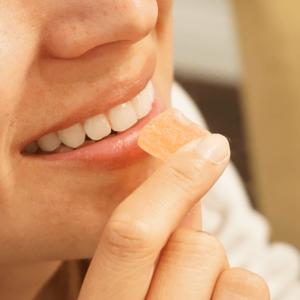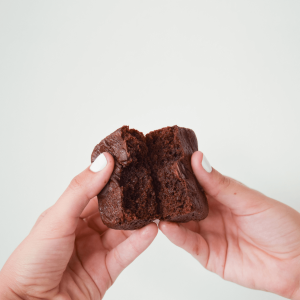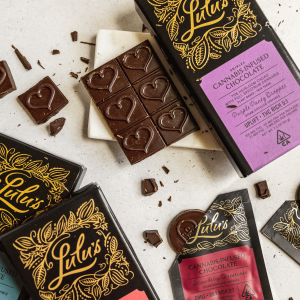If you’ve ever tried edibles, chances are you’ve had an overwhelming or unpleasant experience. This common occurrence highlights the importance of discussing the correct edible dosage.
Edible dosage refers to the amount of THC – the psychoactive compound found in cannabis – contained in edible products. As more OG stoners and new cannabis consumers turn to edibles as a method of consuming cannabis, understanding the correct dosage is critical for both health and safety reasons.
Consuming too much can lead to negative side effects, while too little may not achieve the desired effects. In this blog, we will explore the rise of edibles in cannabis culture, the importance of understanding and measuring dosage, and how proper cannabis dosing can significantly influence the user’s experience when consuming edibles. Let’s begin!
Understanding Edible Dosage
Figuring out the best edible dosage can be a bit tricky. It depends on various factors such as the THC and CBD levels in the product, your tolerance, and how your body processes cannabis. Let’s dig in and break it down.
Basics of Edible Dosage
1. CBD and THC Content in Edibles
THC (Tetrahydrocannabinol) and CBD (Cannabidiol) content are key factors that determine the potency of an edible. THC is the psychoactive compound, responsible for the high, while CBD is non-psychoactive and more associated with medicinal benefits. Edibles can vary significantly in their THC and CBD content, hence, it’s always important to check the product labeling.
2. Bioavailability and Metabolism
Bioavailability refers to the percentage of THC that the body absorbs after consumption. Edibles have a lower bioavailability compared to other cannabis consumption methods due to the digestion process. The THC in edibles is metabolized by the liver, turning it into 11-hydroxy-THC, a more potent compound.

Factors Influencing Dosage
- Individual Tolerance: Just like with alcohol or caffeine, people develop tolerance to THC over time. Regular or experienced cannabis users may have a high tolerance and require higher dosages to achieve the same effects as a beginner. It’s crucial to start with a low dose and gradually increase it if necessary.
- Body Weight and Metabolic Rate: The intoxicating effects of THC are also influenced by body weight and metabolic rate. As a general rule, individuals with more body fat or a slower metabolism may require a higher dosage.
- Strain and Concentration Variations: The potency of the edible cannabis also depends on the strain of cannabis used and its THC concentration. Strains vary in their THC and CBD content, making some more potent than others. Similarly, the concentration of THC in the edible product can also significantly impact the dosage.
Dosage Guidelines
When it comes to the right edible dosage, there are a couple of established guidelines that can help ensure a safe and satisfying experience.
For starters, it’s important to keep regulatory standards in mind. However, regulatory standards for cannabis edibles vary by location.
In states where recreational use is legal, the standard dose is usually 10mg of THC. However, for novices or those with a lower tolerance, starting with a smaller dose of 2.5 mg or 5 mg THC or less can be advisable.
Additionally, the “start low and go slow” approach is a reliable method for finding your optimal dosage. Begin with a minimal amount, then gradually increase it over time, paying attention to how your body reacts to each dose.
Effects of Edible Dosage
The right dosage of edibles not only impacts how intense your experience will be but also affects when and how long the intoxicating effects will last. Plus, everyone reacts differently to different dosages, even high doses, so it’s important to have personalized guidelines for finding what works best for you.
Onset and Duration of Effects
- Delayed Onset Compared to Smoking: Unlike smoking or vaping, where you feel the effects of THC almost immediately, edibles have a delayed onset due to the digestion process. It can take anywhere from 30 minutes to 2 hours to start feeling the effects. This slower onset often leads to a common mistake of consuming more than necessary because people think they haven’t had enough.
- Prolonged Duration of Edible Effects: The effects of THC edibles also stick around much longer compared to other consumption methods. While smoking effects usually fade within 1-3 hours, edibles can keep you feeling the effects for 4 to 12 hours, and sometimes even longer. This extended duration can be great for medical patients seeking long-term symptom relief, but it can be a bit overwhelming for recreational users if they have too much.
Edible Dosage: Managing Intensity and Unwanted Effects
- Strategies for Mitigating Anxiety or Discomfort: One of the most common side effects of consuming too much THC is anxiety or discomfort. But don’t worry, if you start to feel anxious or uncomfortable, there are a few strategies you can try. Take a deep breath and try some meditation to calm your mind. Also, don’t forget to drink water and eat, as it can help dilute the THC in your system. And hey, some people find that CBD can actually counteract the effects of THC and bring them back down to a more comfortable level. So hang in there and take care!
- Importance of a Supportive Environment: The environment in which you enjoy cannabis edibles can have a big impact on your experience. If you’re new to THC edibles or trying a higher dosage, it’s a good idea to do it in a place where you feel comfortable and at ease. It can also be helpful to have a trusted friend nearby who can offer support if you start to feel a bit anxious or uneasy

Calculating Edible Dosage at Home
Understanding how to calculate edible dosage at home is crucial for a safe and enjoyable experience, especially when it comes to THC, THCa, and CBD.
First, check the product labeling. Labels on weed edibles usually provide key information about the amounts of THC, THCa, and CBD. Be sure to look at the total milligrams (mg) of THC and THCa in the entire package as well as per serving.
Next, decode the potency. Potency tells you how concentrated these compounds are. More THC or THCa means a stronger psychoactive effect, while higher CBD offers more relaxing benefits.
Finally, pay attention to the serving size! Edibles often contain multiple servings, so divide the THC, THCa, or CBD content by the number of servings to determine the amount per serving. This helps you manage your intake and achieve the desired effects.
DIY Edible Preparation Tips
When it comes to preparing your own homemade edibles, there are a couple of important factors to keep in mind to ensure both safety and a great experience.
First, let’s talk about homogenizing cannabinoids in your recipes. It’s a fancy way of saying that you need to evenly distribute the cannabis extract throughout the recipe to make sure each bite has a consistent potency.
If you’re crafting weed edibles at home, just give it a good stir and make sure it’s evenly mixed. This way, every portion you enjoy will have a somewhat predictable effect.
Next, precision in ingredient measurement is key. This applies to both the food ingredients and the cannabis extract.
Use a reliable digital scale for accurate measurements and make sure the cannabis dosage per serving matches your tolerance level and desired effect.
Remember, it’s always safer to start with a lower dose and gradually increase to a high dose as you get more comfortable with its effects.

Edible Dosage: Risks and Precautions
Overindulging in cannabis-infused edibles can lead to an overwhelming experience, commonly known as an ‘edible overdose’. This might cause heightened pain and anxiety symptoms, paranoia, and uncomfortable physical sensations.
If you find yourself in this situation, remember to stay calm, hydrate, and rest in a safe, comfortable environment. In severe cases, seeking medical attention may be necessary, so don’t hesitate to reach out for help if symptoms persist or worsen.
It’s important to note that cannabis edibles can interact with certain medications, potentially affecting their effectiveness and causing unexpected side effects.
Being aware of these drug interactions, especially if you’re on prescription medications, is crucial. Always consult with healthcare professionals before incorporating weed edibles into your routine to ensure a safe and positive experience.
Edible Dosage in Different Forms
THC Edibles come in a wide range of product types, each with their own unique features and dosage considerations.
Understanding the different forms will help you make an informed decision and optimize your cannabis experience. Let’s explore.
Varieties of Edible Products
Gummies, Brownies, and Cookies
Gummies, brownies, and cookies are among the most popular forms of cannabis edibles. They are typically infused with a pre-measured dose of THC or CBD, providing a tasty and discrete way to enjoy cannabis.
Dosages in these products can vary significantly, from 2.5 mg THC to 100mg per piece, so it’s crucial to read the product label for exact information. The onset of effects can take anywhere from 30 minutes to 2 hours, with effects lasting up to 12 hours depending on the dosage.

Capsules, Tinctures, and Beverages
Capsules, tinctures, and beverages represent another category of cannabis edibles. Capsules contain a specific dose of cannabis extract and are swallowed like a pill, providing a smokeless and odorless consumption method for medical patients.
Tinctures are highly concentrated cannabis plant extracts that are typically dropped under the tongue for rapid absorption.
Beverages, on the other hand, can include anything from non-alcoholic beers to teas – all infused with varying levels of THC and/or CBD (mg THC or mg CBD). These forms of THC edibles tend to kick in faster than gummies, brownies, and cookies, often within 15-45 minutes, but the effects usually last for a shorter duration.
As always, make sure to check the product label to understand the specific dosage and how long it takes to kick in.
Summary
In summary, understanding dosage is super important when it comes to enjoying weed edibles safely. Make sure to check out the product labeling, consider the THC and CBD potency, and keep an eye on the serving size to have a predictable and enjoyable edible experience.
If you’re making homemade weed edibles, be extra careful with the measurement and distribution of cannabis extract for consistent potency. And don’t forget to be aware of the risks and take necessary precautions to avoid overconsumption. Different edibles have different dosage considerations and effects, so it’s always good to stay informed.
Exciting things are happening in the world of weed edibles, like more user-friendly labeling, precision dosing technologies, and a focus on educating cannabis consumers more about safe and responsible use. So keep an eye out for new trends and innovations!

Frequently Asked Questions
1. How much THC or CBD should I consume if I’m new to cannabis edibles?
If you’re new to cannabis edibles, it’s best to start with a low dosage to understand how your body reacts to it. A common starting dose is around 5mg of THC or CBD. Always allow enough time (2-3 hours) to feel the full effects before deciding to consume more.
2. How long does it take for the effects of edibles to kick in?
The onset of effects from consuming cannabis edibles can vary widely depending on the type of edible and individual factors like metabolism and stomach content. Generally, effects could start to be felt anywhere from 30 minutes to 2 hours after consumption.
3. Can I mix cannabis edibles with alcohol or other substances?
It’s not recommended to mix edibles with alcohol or other substances as it can enhance the effects and potentially lead to an unwanted or unpleasant effects experience. Plus, it can be harder to control your intake and effects when mixing substances. Always consume responsibly and be aware of how different substances can interact.

 Rewards
Rewards





